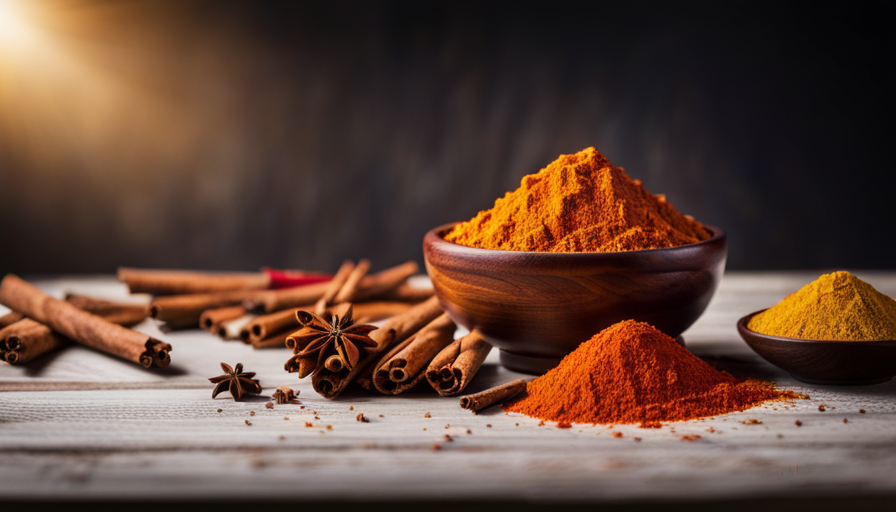If you are a fan of tea and want to try a new, healthy way to enjoy your favorite drink, turmeric tea might be the perfect option for you. Turmeric, a yellow spice often found in Indian and Middle Eastern dishes, has become increasingly popular as a superfood with a wide range of health benefits. It has been utilized in Ayurvedic medicine for centuries to address a variety of health concerns, such as inflammation and digestive problems, and is known for its potent antioxidant and anti-inflammatory properties.
Making turmeric tea is a simple and delicious way to incorporate this powerful spice into your daily routine. Whether you prefer a classic, spiced chai flavor or a refreshing iced tea, there are plenty of variations to choose from.
In this article, we’ll guide you through the process of preparing turmeric tea, discuss its health benefits and potential side effects, and provide you with some additional recipes and uses for this versatile spice.
Key Takeaways
- Turmeric tea is a healthy and delicious way to incorporate the spice into your daily routine.
- Drinking turmeric tea regularly can aid in weight loss, improve digestion, reduce inflammation, and improve brain function.
- Turmeric tea can be customized with different spice combinations and sweetening options to cater to your taste preferences.
- Turmeric may interact with certain medications, so it’s best to consult with a healthcare professional before adding it to your diet.
How to Prepare Turmeric Tea
Now, let’s get started on how you can prepare your delicious and healthy turmeric tea! First, gather your ingredients: turmeric powder, water, honey, and lemon (optional).
For a single serving, you’ll need 1 teaspoon of turmeric powder and 2 cups of water.
Bring the water to a boil, add the turmeric powder, and let it simmer for 10-15 minutes. Strain the mixture into a cup and add honey and lemon to taste. You can also add other spices such as ginger or cinnamon for an extra kick.
Drinking turmeric tea regularly can aid in weight loss due to its anti-inflammatory properties and can also improve digestion.
Now that you know how to prepare your turmeric tea, let’s explore the different variations of turmeric tea you can make to switch things up and enjoy the benefits in different ways.
Different Variations of Turmeric Tea
There are various ways to incorporate this flavorful spice into your daily hot beverage routine. If you’re looking to switch up your turmeric tea game, you can try different spice combinations and sweetening options to cater to your taste preferences. Here are some variations of turmeric tea that you can experiment with:
| Spice Combination | Sweetening Option | Additional Ingredients |
|---|---|---|
| Turmeric, Cinnamon, Ginger, Black Pepper | Honey, Maple Syrup, Stevia | Lemon Juice, Vanilla Extract |
| Turmeric, Cardamom, Clove, Cinnamon | Agave Nectar, Brown Sugar, Coconut Sugar | Almond Milk, Coconut Milk, Black Tea |
| Turmeric, Fennel, Star Anise, Black Pepper | Molasses, Honey, Maple Syrup | Orange Peel, Basil Leaves, Chamomile Tea |
Aside from the ones mentioned above, you can also add other herbs and spices like rosemary, thyme, nutmeg, and cayenne pepper to your turmeric tea. The possibilities are endless! By exploring different variations of turmeric tea, you not only get to enjoy its health benefits, but also savor its unique taste.
Moving forward, let’s delve into the health benefits of turmeric tea and how it can improve your overall well-being.
Health Benefits of Turmeric Tea
Get ready to spice up your life and reap the rewards of this golden elixir – sipping on turmeric tea can do wonders for your health and well-being.
Drinking turmeric tea regularly can help reduce inflammation in your body, thanks to the curcumin – the active ingredient found in turmeric. It also contains antioxidants that can help protect your body from oxidative damage caused by free radicals.
Turmeric tea recipes are easy to make and can be customized to your liking. However, it’s important to note that turmeric tea has its benefits and drawbacks. While it can help improve digestion and boost your immune system, it may also interfere with certain medications and cause stomach upset if consumed in excess.
As with any herbal remedy, it’s important to consult with your healthcare provider before adding turmeric tea to your diet. With that said, let’s move on to the next section about dosage and possible side effects.
Dosage and Possible Side Effects
When it comes to taking turmeric, it’s important to know the recommended dosage and possible side effects.
As a general rule, it’s safe to consume up to 3 grams of turmeric per day. However, it’s always best to consult with a healthcare professional before starting any new supplement regimen.
Possible side effects of consuming too much turmeric include stomach upset and diarrhea, and it may also interact with certain medications.
Recommended Dosage
To get the most out of turmeric tea, you should aim for a daily dosage of 500-2,000 milligrams of curcumin, the active ingredient in turmeric. This dosage range has been shown to provide the most health benefits, including reducing inflammation and improving brain function.
There are various ways to incorporate turmeric into your diet, but turmeric tea is a simple and effective method. There are many turmeric tea recipes available, but a basic recipe involves boiling water and adding 1-2 teaspoons of ground turmeric. You can also add other ingredients such as ginger, honey, or lemon to enhance the flavor and health benefits.
However, it’s important to note that excessive consumption of turmeric may lead to certain side effects, which will be discussed in the next section.
Possible Side Effects
It’s important to be aware of possible side effects when incorporating turmeric into your routine for making tea. While turmeric is generally safe for most people, excessive consumption of curcumin can lead to nausea and diarrhea. To avoid any unpleasant symptoms, it’s best to stick to the recommended dosage.
Here are some other possible side effects of turmeric tea to keep in mind:
| Side Effect | Description |
|---|---|
| Stomach Issues | Turmeric tea can cause stomach upset, especially if consumed on an empty stomach. |
| Blood Thinning | Turmeric tea can act as a blood thinner, which can be dangerous for people who are already taking blood-thinning medications. |
| Allergic Reaction | Some people may experience an allergic reaction to turmeric, which can cause hives, rash, or difficulty breathing. |
| Interaction with Medications | Turmeric tea can interact with certain medications, including blood thinners, diabetes medications, and stomach acid reducers. |
It’s important to be aware of these possible side effects and to consult with your healthcare provider before incorporating turmeric tea into your routine, especially if you have any underlying health conditions or are taking medications. In the next section, we’ll discuss some precautions to take when using turmeric to make tea.
Precautions to Take When Using Turmeric
Before you start adding turmeric to your tea, it’s important to take some precautions to ensure you’re using it safely and effectively. First, you should be mindful of the turmeric dosage you’re adding to your tea. While turmeric is generally considered safe, it’s important not to exceed the recommended daily dosage of 500mg to 2g per day.
Consuming too much turmeric can lead to gastrointestinal issues, such as stomach upset and diarrhea. Another precaution to take when using turmeric is to be aware of any potential turmeric side effects. Turmeric is generally safe for most people, but some individuals may experience an allergic reaction or interact with certain medications.
For example, turmeric may interact with blood-thinning medications, so it’s important to talk to your doctor before adding turmeric to your diet if you’re taking any medications. By taking these precautions, you can use turmeric safely and effectively in your tea and reap its many health benefits.
As you move on to exploring additional recipes and uses for turmeric, keep in mind the dosage and potential side effects discussed earlier. There are many creative ways to incorporate turmeric into your diet, so don’t be afraid to experiment and enjoy the many benefits of this powerful spice.
Additional Recipes and Uses for Turmeric
If you’re looking for new ways to incorporate turmeric into your routine, try making a delicious and healthy turmeric smoothie. This can be a great way to start your day and get a boost of antioxidants and anti-inflammatory properties.
Alternatively, you can also use turmeric to create a soothing and nourishing face mask that can help with acne, inflammation, and other skin issues.
Give these recipes a try and see how turmeric can benefit your health and beauty routine.
Turmeric Smoothie Recipe
For a delicious and healthy way to start your day, whip up this creamy and flavorful turmeric smoothie recipe that will knock your socks off! Turmeric smoothies are a great way to incorporate this superfood into your diet and can be made in a variety of different ways to suit your taste preferences.
Here are some variations and benefits of turmeric in smoothies:
-
Turmeric and Ginger Smoothie: Add some fresh ginger to your smoothie for an extra anti-inflammatory boost.
-
Mango Turmeric Smoothie: Add some frozen mango and coconut milk to give your smoothie a tropical twist.
-
Turmeric Banana Smoothie: Combine turmeric, frozen banana, almond milk, and a few dates for a sweet and creamy treat.
Not only do turmeric smoothies taste great, but they also offer a multitude of health benefits. Turmeric contains a compound called curcumin, which has been shown to have anti-inflammatory and antioxidant properties.
Adding turmeric to your smoothies may help reduce inflammation in the body and protect against chronic diseases like cancer and heart disease.
Now that you know how to make a delicious and healthy turmeric smoothie, let’s move on to another way to incorporate this superfood into your routine with a turmeric face mask recipe.
Turmeric Face Mask Recipe
Let’s spice up our skincare routine with a DIY turmeric face mask that will leave our skin feeling refreshed and glowing. Turmeric has been used for centuries in Ayurvedic medicine to treat various skin conditions, and its benefits are now being recognized by the Western world. The active ingredient in turmeric, curcumin, has anti-inflammatory and antioxidant properties, making it an effective ingredient in skincare products.
To create a DIY turmeric face mask, all you need is a few simple ingredients that you can find in your kitchen. Mix together 1 tablespoon of turmeric powder, 1 tablespoon of honey, and 1 tablespoon of plain yogurt in a bowl. Apply the mixture to your face and leave it on for 15-20 minutes before rinsing it off with warm water. The table below summarizes the benefits of each ingredient in the face mask:
| Ingredient | Benefits |
|---|---|
| Turmeric Powder | Anti-inflammatory, antioxidant, brightening |
| Honey | Moisturizing, antibacterial, anti-inflammatory |
| Plain Yogurt | Exfoliating, brightening, moisturizing |
Using a turmeric face mask once a week can help to improve the overall appearance of your skin, leaving it looking brighter and feeling softer. Give it a try and see the difference for yourself!
Moving on to the next section, let’s take a look at some sources and references that support the use of turmeric in skincare.
Sources and References
There are numerous sources and references available online that provide information on how to use turmeric for tea. For example, the popular health website Healthline states that over 6,000 studies have been conducted on the health benefits of turmeric. Other sources, such as the Ayurvedic website Banyan Botanicals and the wellness website MindBodyGreen, also offer detailed information on how to use turmeric for tea.
Here are four key points to consider when using turmeric for tea, as recommended by these sources:
- Use high-quality turmeric powder or fresh turmeric root for maximum benefits.
- Add black pepper to the tea to enhance the absorption of the turmeric’s active compound, curcumin.
- Experiment with different ingredients to create a flavorful and nutritious turmeric tea, such as ginger, honey, lemon, and cinnamon.
- It’s important to note that turmeric may interact with certain medications, so it’s best to consult with a healthcare professional before adding it to your diet.
By consulting these sources and following these tips, you can safely and effectively use turmeric for tea and reap its many health benefits.
Frequently Asked Questions
Can turmeric tea be used for weight loss?
Yes, turmeric tea can aid in weight loss due to its anti-inflammatory properties and ability to increase metabolism. Turmeric tea recipe involves steeping turmeric in hot water and adding honey and lemon. Turmeric tea benefits also include reducing inflammation and improving brain function.
How long should turmeric tea be steeped for maximum health benefits?
For maximum turmeric tea benefits, steep for at least 10 minutes to allow the curcumin to release. Longer steeping times may increase flavor, but may also reduce the potency of the curcumin.
Can turmeric tea be consumed during pregnancy?
Did you know that over 90% of pregnant women experience some form of discomfort during their pregnancy? While turmeric tea benefits are well-known, there are precautions during pregnancy. Alternative remedies for pregnancy discomfort using turmeric tea include consulting with your healthcare provider and trying other natural remedies.
Is it safe to drink turmeric tea every day?
Drinking turmeric tea every day is generally safe and can provide numerous health benefits. However, it is recommended to limit intake to one to three grams per day. Consult with a healthcare provider before consuming turmeric tea regularly.
Can turmeric tea help with arthritis pain?
Oh, sure, turmeric tea can help with arthritis pain. It’s not like there are any actual medications out there. Turmeric has anti-inflammatory properties, so drinking it regularly could help manage inflammation and pain.
Conclusion
Congratulations, you’re now equipped with the knowledge and skills to prepare and enjoy a delicious cup of turmeric tea. By following the simple steps outlined in this article, you can create a warming and comforting drink that’s both tasty and packed with health benefits.
As you sip on your steaming cup of turmeric tea, imagine the golden hues emanating from the mug and filling your senses with warmth and comfort. Picture the anti-inflammatory and antioxidant properties of turmeric working their way through your body, helping to reduce inflammation and protect against disease.
Remember to take precautions when using turmeric, and consult with your healthcare provider before adding it to your daily routine.
With its numerous health benefits and delicious taste, turmeric tea is a great addition to any diet. So go ahead, give it a try and enjoy the many benefits of this powerful spice.










